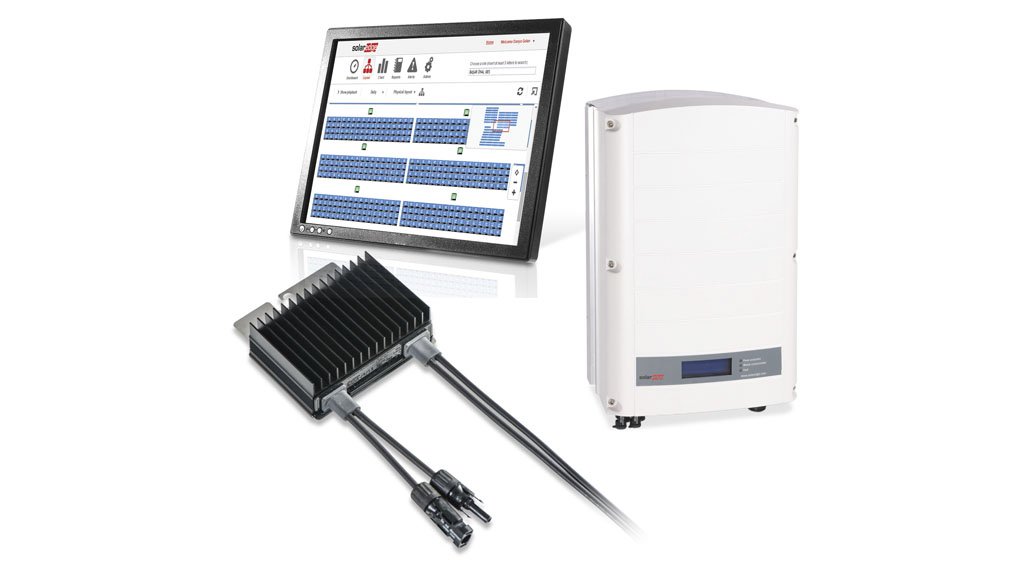The new intelligent inverter system from photovoltaic (PV) company SolarEdge has an automatic safety control feature that allows the system to use a module-level voltage shutdown, where the PV array is reduced to a safe direct current (dc) voltage in the event of an alternating current (ac) shut down during installation, maintenance, firefighting or other emergencies.
SolarEdge – a part of electrical solutions provider Magnet Energy – recently added new components to the long range of components for solar power systems that Magnet Energy supplies.
The inverter solution is capable of enhancing the performance of clean, renewable solar energy in residential and commercial solar PV installations, as well as in small utility-scale solar installations.
“Built-in module-level monitoring provides full visibility of system performance, fault detection and remote troubleshooting through an easily accessible cloud-based monitoring platform. This system also indicates exactly how much more energy the upgraded system is producing,” explains Magnet Energy projects head Ryan Groger.
He points out that SolarEdge, which optimises the way power is harvested and managed, consists of power optimisers, inverters, storage solutions and a cloud-based monitoring platform. The SolarEdge dc optimised inverter system maximises power generation at the individual PV module level, thereby lowering the cost of energy produced by the solar PV system.
“Apart from new installations, this system has also been designed for safe and easy retrofit to extract more energy from existing underperforming PV systems. By replacing the conventional inverter with a compact and lightweight SolarEdge inverter and adding power optimisers to every module on the roof, the efficiency of the PV system is significantly improved,” he says.
Groger explains that, unlike conventional PV installations, where string inverter systems lower output to the level of the lowest-performing module, the SolarEdge system alleviates power losses, owing to a mismatch between modules and extracts the maximum energy from every module, regardless of the performance of other modules in the string.
With this system, weaker-performing modules do not affect strong ones. The greater the mismatch between modules in a system, the greater the energy that can be retrieved by retrofitting it with a SolarEdge system.
He points out that the SolarEdge power optimiser is a dc to dc converter, which is connected by installers to each PV module, or embedded by module manufacturers, replacing the traditional solar junction box.
Power optimisers increase energy output from PV systems by constantly tracking the maximum power point (MPP) of each module individually. He explains that MPPs also communicate performance data to the monitoring portal for enhanced, cost-effective module-level maintenance. Each power optimiser is equipped with a safety mechanism, which automatically reduces the module dc voltage to a safe level (1V) in the event of the inverter or grid power shutting down.
“Connectors or cables in a PV system that are improperly connected or are damaged, may cause an electric arc. Arcs generate heat, which can cause fires and they also pose an electrocution risk to those working near them. SolarEdge inverters comply with the UL1699B arc detection standard and are designed to detect arcs as specified in this standard,” Groger says.
SolarEdge dc to ac three-phase inverters operate in conjunction with power optimisers to combine digital control technology with an efficient power conversion design. He says that the inverters do this to achieve reliable solar power harvesting. Fixed-voltage technology ensures the solar inverter always operates at its optimal input voltage in all environmental conditions regardless of the number of modules in a string.
“Because maximum power point tracking (MPPT) and voltage management are handled separately for each module by the power optimiser, the inverter is only responsible for dc to ac inversion and is therefore much more compact than equivalent string inverters,” he explains.
He says that when working with inverters, power optimisers automatically maintain a fixed string voltage. This feature, coupled with MPPT for each module, which allows for multiple orientations, tilts and module types in the same string, gives installers greater flexibility to design optimal PV systems.
A proprietary data monitoring receiver is integrated into the inverter and aggregates the power optimiser performance data from each PV module. This data is then transmitted to the Web and accessed through the SolarEdge monitoring platform.
He explains that the portal, which is localised on a virtual site map for on-site and remote troubleshooting at the module level, automatically provides alerts for accurate and immediate fault detection. Module performance is communicated across the existing dc cabling, so that no extra wiring is required.
PV installers and system owners can also use their mobile devices to view the most updated data for remote monitoring, in order to maximise solar energy harvesting and uptime of the system.
SolarEdge technology, which is available throughout South Africa from Magnet Energy, enables module manufacturers, installers and system owners to maximise power production. This is achieved through module- level MPPT, optimal roof use through constraint-free design, and accurate troubleshooting through module-level monitoring. An important safety benefit of the SolarEdge system is the dc shutdown mechanism during maintenance, or in the event of an emergency.
Edited by: Zandile Mavuso
Creamer Media Senior Deputy Editor: Features
EMAIL THIS ARTICLE SAVE THIS ARTICLE
ARTICLE ENQUIRY
To subscribe email subscriptions@creamermedia.co.za or click here
To advertise email advertising@creamermedia.co.za or click here













